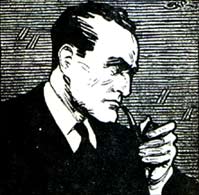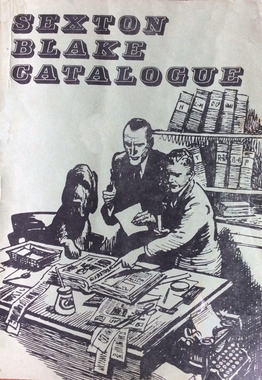Related Research Articles
A pen name is a pseudonym adopted by an author and printed on the title page or by-line of their works in place of their real name.

Crime fiction, detective story, murder mystery, mystery novel, and police novel are terms used to describe narratives that centre on criminal acts and especially on the investigation, either by an amateur or a professional detective, of a crime, often a murder. It is usually distinguished from mainstream fiction and other genres such as historical fiction or science fiction, but the boundaries are indistinct. Crime fiction has multiple subgenres, including detective fiction, courtroom drama, hard-boiled fiction, and legal thrillers. Most crime drama focuses on crime investigation and does not feature the courtroom. Suspense and mystery are key elements that are nearly ubiquitous to the genre.

Mystery is a fiction genre where the nature of an event, usually a murder or other crime, remains mysterious until the end of the story. Often within a closed circle of suspects, each suspect is usually provided with a credible motive and a reasonable opportunity for committing the crime. The central character is often a detective, who eventually solves the mystery by logical deduction from facts presented to the reader. Some mystery books are non-fiction. Mystery fiction can be detective stories in which the emphasis is on the puzzle or suspense element and its logical solution such as a whodunit. Mystery fiction can be contrasted with hardboiled detective stories, which focus on action and gritty realism.

Evan Hunter, born Salvatore Albert Lombino, was an American author and screenwriter best known for his 87th Precinct novels, written under his Ed McBain pen name, and the novel upon which the film Blackboard Jungle was based.

Ruth Barbara Rendell, Baroness Rendell of Babergh, was an English author of thrillers and psychological murder mysteries.

Sexton Blake is a fictional character, a detective who has been featured in many British comic strips, novels and dramatic productions since 1893. Sexton Blake adventures were featured in a wide variety of British and international publications from 1893 to 1978, comprising more than 4,000 stories by some 200 different authors. Blake was also the hero of numerous silent and sound films, radio serials, and a 1960s ITV television series.

Walter Herman Wager was an American crime and espionage-thriller novelist and former editor-in-chief of Playbill magazine. The movie Telefon, starring Charles Bronson, was inspired by his novel of the same name. His book 58 Minutes was adapted into Die Hard 2, starring Bruce Willis.
Lewis Padgett was the joint pseudonym of the science fiction authors and spouses Henry Kuttner and C. L. Moore, taken from their mothers' maiden names. They also used the pseudonyms Lawrence O'Donnell and C. H. Liddell, as well as collaborating under their own names.

Donald Edwin Westlake was an American writer with more than one hundred novels and non-fiction books to his credit. He specialized in crime fiction, especially comic capers, with an occasional foray into science fiction and other genres. Westlake created two professional criminal characters who each starred in a long-running series: the relentless, hardboiled Parker, and John Dortmunder, who featured in a more humorous series.
Michael Collins is the best-known pseudonym of Dennis Lynds, an American author who primarily wrote mystery fiction.
Robert Edward Vardeman is an American science fiction fan and writer.

William Bayer is an American novelist, the author of twenty-one books including The New York Times best-sellers Switch and Pattern Crimes.
Gerald Verner (1897–1980) was a writer of thrillers, writing more than 120 novels translated into over 35 languages. Many of these were adapted into radio serials, stage plays and films.
Howard Linskey is a British novelist and former journalist. He is best known for the David Blake crime fiction series. This series and his subsequent crime novels are set in the north east of England. Linskey is also the author of two historical thrillers set during the Second World War.

The Sexton Blake Library was a story paper of the first two-thirds of the 20th century, published by Amalgamated Press. It featured the adventures of private detective Sexton Blake, his boy assistant Tinker and their dog Pedro.

Sexton Blake is a fictional detective who has been featured in many British comic strips, novels, and dramatic productions since 1893. He was featured in various British publications from 1893 to 1978 in a variety of formats: single-issue adventures, short stories, serials, and comic strips. In total, Blake appeared in more than 4,000 stories by over 200 different authors. During its golden age (1920s-1940s), Blake's adventures were widely read and translated into at least twenty different languages, including Swedish, Norwegian, Finnish, Dutch, Spanish, German, Portuguese, Italian, French, Arabic, Hindi, and Afrikaans.
Sexton Blake is a fictional detective who has been featured in many British comic strips, novels, and dramatic productions since 1893. He was featured in various British publications from 1893 to 1978 in a variety of formats: single-issue adventures, short stories, serials, and comic strips. In total, Blake appeared in more than 4,000 stories by over 200 different authors.
During its golden age (1920s-1940s), Blake's adventures were widely read and translated into at least twenty different languages, including Swedish, Norwegian, Finnish, Dutch, Spanish, German, Portuguese, Italian, French, Arabic, Hindi, and Afrikaans.
Sexton Blake is a fictional detective who has been featured in many British comic strips, novels, and dramatic productions since 1893. He was featured in various British publications from 1893 to 1978 in a variety of formats: single-issue adventures, short stories, serials, and comic strips. In total, Blake appeared in more than 4,000 stories by over 200 different authors.
Sexton Blake is a fictional detective who has been featured in many British comic strips, novels, and dramatic productions since 1893. He was featured in various British publications from 1893 to 1978 in a variety of formats: single-issue adventures, short stories, serials, and comic strips. In total, Blake appeared in more than 4,000 stories by over 200 different authors.
References
- 1 2 Carty, T.J. (2015). A Dictionary of Literary Pseudonyms in the English Language. Routledge. ISBN 978-1135955786.
- 1 2 3 Kalat, David (2012). The Strange Case of Dr. Mabuse: A Study of the Twelve Films and Five Novels. McFarland. ISBN 978-1476601076.
- ↑ "Murder at Site Three (1959)". bfi.org.uk. Archived from the original on January 27, 2018.
- ↑ Hendrix, Grady (2017). Paperbacks from Hell: The Twisted History of '70s and '80s Horror Fiction. Quirk Books. ISBN 978-1594749827.